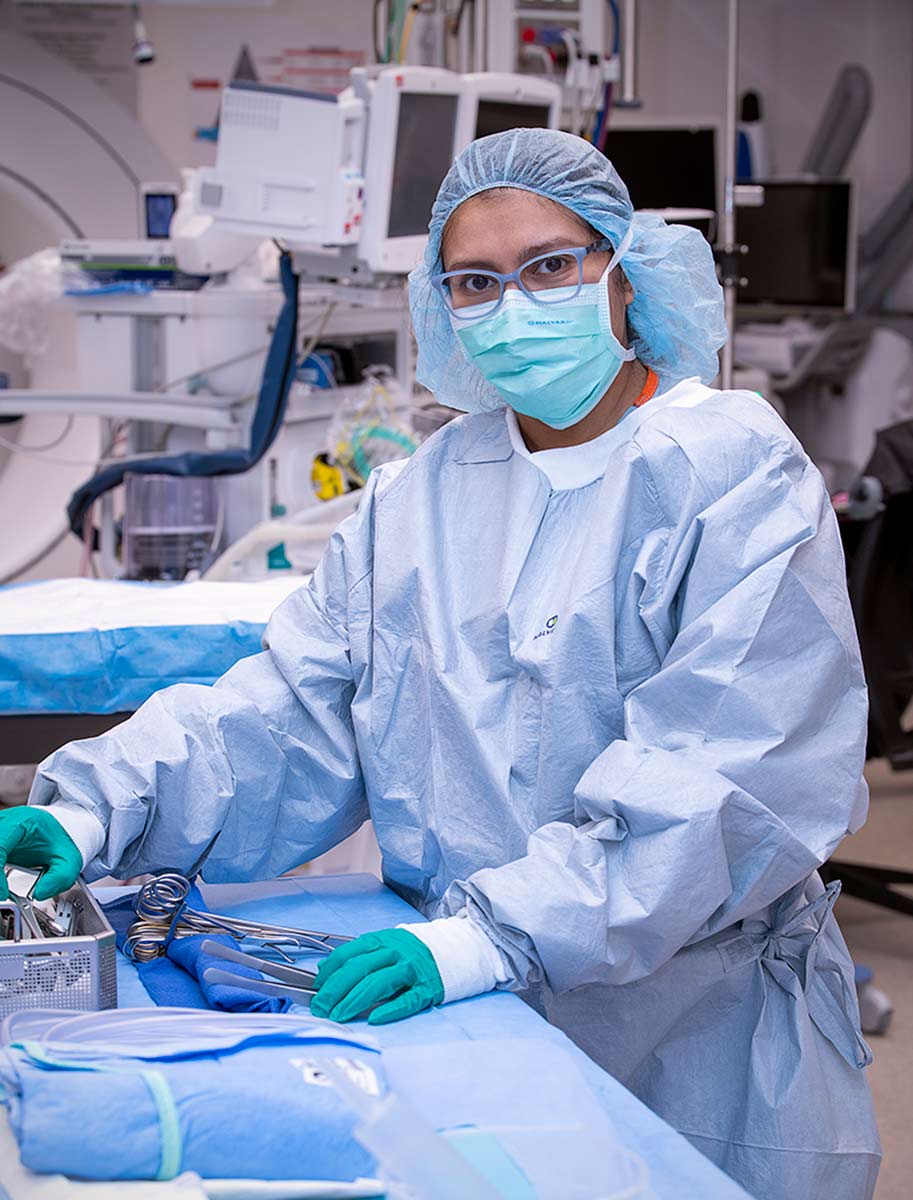Ohio State, Columbus State build blueprint for job-ready surgical techs to fill vital need

There’s a paper Tom Poole has kept on his desk for two years illustrating a plan to increase the number of surgical technologists at The Ohio State University Wexner Medical Center. The role is integral to operating room procedures, and there simply aren’t enough certified surgical technologists available.
Poole, director of talent acquisition at the Ohio State Wexner Medical Center, is charged with overseeing recruitment for the entire health system. The job has become increasingly difficult since the pandemic, when some seasoned allied health care employees retired early or switched careers. Finding experienced surgical technologists has proved particularly vexing.
Faced with 85 openings, Poole and Dennis Delisle, ScD, executive director at the Wexner Medical Center, approached Columbus State Community College to fulfill one piece of this blueprint: finding a way to triple the number of their yearly graduates. Columbus State has limited space in the program and has had to turn away applicants in the past.
“We started with, ‘Our answer is yes. What questions do you have?’” Dr. Delisle says.
Leaders from both institutions devised a plan to fill the surgical technologist pipeline by collaborating. Columbus State provides the curriculum and accreditation. Ohio State provides instructional support and clinical training space.
Both organizations officially announced the collaboration on Feb. 28, 2024 — two years to the day after Poole’s paper logic model was designed to increase the surgical technology pipeline.
What do surgical technologists do?
Surgical technologists play a vital role in the operating room (OR). These “surg techs” promote patient safety by ensuring the sterility, safety and quality of the OR. During surgery, they anticipate the surgeons’ needs at any given moment.
At Ohio State, surgical technologists support every operating room — from the main campus to ambulatory surgery centers throughout central Ohio. They work in every area of surgery, from complex cancer surgery and transplants to orthopedics and sports medicine.
“The role of a surgical technologist is incredibly vital. They learn specifically about surgical instruments, sterile technique and surgical procedures. Truly, a surgical tech needs to be able to understand a surgical procedure as well as anyone else on the surgical team,” says Paige Starkey, associate director for surgical technologists at The Ohio State University Comprehensive Cancer Center – Arthur G. James Cancer Hospital and Richard J. Solove Research Institute (OSUCCC – James).
The national shortage of surgical techs has left surgeons and health systems, in general, realizing how hard it is to run an operating room without these critical team members.
“You can try to fill their role with other providers, but these individuals are specifically trained to maintain a safe and efficient operating room,” says Starkey.
Starkey knows firsthand how essential the surgical technologist role is in the OR after scrubbing in for surgery hundreds of times. Working in the cardiovascular operating rooms, she recalls times when the surgical team had to change course mid-procedure. Anticipating what the surgeon needs in any scenario made the procedure smoother for the whole team and kept the patient safe. “You go home feeling very satisfied that, whether or not anyone else noticed, you knew you were 100% part of saving that patient's life,” she says.
More jobs available than surgical technologists to fill them
 There will be 8,600 openings for surgical assistants and technologists each year for the next decade, according to the U.S. Bureau of Labor Statistics. Columbus State Community College (Columbus State) offers the largest surgical technology accredited program in central Ohio, with only 24 spots available. At one point at Ohio State, Poole needed to hire 85.
There will be 8,600 openings for surgical assistants and technologists each year for the next decade, according to the U.S. Bureau of Labor Statistics. Columbus State Community College (Columbus State) offers the largest surgical technology accredited program in central Ohio, with only 24 spots available. At one point at Ohio State, Poole needed to hire 85.
When Poole and Dr. Delisle approached Columbus State leaders to expand the program, they learned that the college lacked enough space and instructors. Ohio State has both.
“What fostered many of these conversations is that both our institutions could benefit from this partnership,” says Allie Upchurch, project manager for the Office of Talent Strategy at Columbus State.
It took two years to work out the details. In August 2024, the first cohort of the combined surgical technology program will launch with Columbus State’s curriculum and accreditation taught by Ohio State instructors working as adjuncts for Columbus State. Students will train at the Surgical Skills Lab at the Jameson Crane Sports Medicine Institute.
Collaborating to create a cutting-edge surgical tech training partnership
The Columbus State surgical technology program is a two-year accredited associate degree program. “They learn so much from the classroom and clinical rotations that they're ready to work in the OR as soon as they graduate,” says Anya Nazarova, the surgical technologist program coordinator at Columbus State.
Most surgical technology programs occur in mock OR laboratories housed in a community college, with ancillary clinical experiences in real-world health care settings. Partnering with Ohio State allows Columbus State students to train in the Crane Sports Medicine Institute’s state-of-the-art operating rooms alongside other clinical training programs.
Dr. Delisle says the synergy behind this program is that both institutions were trying to solve interconnected problems.
“By partnering, we both win and, most importantly, our community wins when we create a career path,” Dr. Delisle says.
Day in the life of a surgical technologist
Vanessa Ramirez joined this year’s soft launch of the degree program while working as a perioperative technician at Ohio State. As part of the group known as “Cohort 0,” Ramirez has the opportunity to train for a more integral role in patient care.
“This is impacting the patient beyond my imagination. They're receiving life-changing surgery, and I get to see it firsthand basically every day of the week.”
Learning the instruments for various kinds of surgery means there’s a lot of material to cover. In one recent surgery, Ramirez scrubbed in for a thyroid removal surgery that included two surgeons, residents and medical students. “The surgeons can’t stop what they’re doing with the patient to look for instruments. The surgical tech has to be ready with the instrument or sutures so the surgeon never has to look up. You have to be able to accommodate two surgeons,” Ramirez says.
The teaching hospital culture at Ohio State makes it easy for Ramirez to ask questions and build confidence during her day job. “Being at a teaching hospital reassures me that I can continue my education here, ask questions, and the people around me are willing to answer and help me along the way,” she says.
Planning for the future of health care
For surgical technologists, the associate degree can be a career unto itself or a rung on a health care career ladder. Ramirez hopes to spend a few years as a surgical technologist and then continue training to assist more directly in surgery as a certified first assistant.
“We're offering people careers and futures that weren’t on their map before,” Dr. Delisle says.
The program is an opportunity for Ohio State and Columbus State to design a blueprint for more like it. “The most exciting part for me is the potential to collaborate in a space where it's a high-need field,” Allie Upchurch says.
Needs at Ohio State and other hospitals in the area continue to grow. “When we think about challenges today and in the future, if we can create a model that others can leverage, I think that's a good thing,” Dr. Delisle says. “We’re building a meaningful pipeline to strengthen the workforce across central Ohio.”
Learn more about the surgical technologist associate degree program and apply for the fall 2024 semester. Applications are due April 1, 2024.

It means more to be a Buckeye
No matter your career path, at Ohio State, you’re a valuable part of our team.
Find your career at Ohio State




